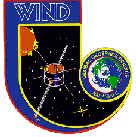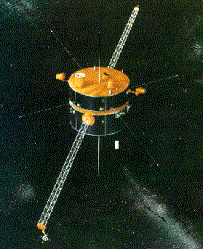WIND
The missionThe WIND spacecraft is the first of two spacecraft which make up NASA?s Global Geospace Science (GGS) contribution to the International Solar Terrestrial Physics (ISTP) Programme. The overall goal of the ISTP programme is to understand the physical mechanisms controlling the transport of mass, momentum and energy from the solar wind into the Earth's magnetosphere.
 Launch
took place on November 1st, 1994. After a series of orbital manoeuvres close to
the Earth and several lunar encounters, it headed upstream to a halo orbit about the L1
Lagrangian point, acting as a monitor of solar wind conditions upstream of the Earth.
More recently this task has been taken over by ACE, and WIND is now engaged in a series
of highly-eccentric "petal orbits" and "lunar backflips" about the Earth-moon system.
Launch
took place on November 1st, 1994. After a series of orbital manoeuvres close to
the Earth and several lunar encounters, it headed upstream to a halo orbit about the L1
Lagrangian point, acting as a monitor of solar wind conditions upstream of the Earth.
More recently this task has been taken over by ACE, and WIND is now engaged in a series
of highly-eccentric "petal orbits" and "lunar backflips" about the Earth-moon system.
The spacecraft carries nine instruments to measure particles, magnetic and electric fields. Dr. Chris Owen at MSSL is a member of the magnetometer (MFI) team (P.I. Dr. Ron Lepping, NASA/Goddard Space Flight Center)
Science ObjectivesThe science objectives of the WIND mission are:
- Provide complete plasma, energetic particle, and magnetic field input for magnetospheric and ionospheric studies.
- Determine the magnetospheric output to interplanetary space in the up-stream region
- Investigate basic plasma processes occurring in the near-Earth solar wind
- Provide baseline ecliptic plane observations to be used in heliospheric latitudes from ULYSSES.
More details are available on the ISTP/Wind home page.
 The Magnetic Fields Investigation (MFI) Instrument
The Magnetic Fields Investigation (MFI) Instrument
The MFI instrument consists of dual triaxial fluxgate rnagnetometers mounted on a 12-meter radial boom, and a data processing and control unit within the body of the spacecraft. It has a very wide capability, measuring magnetic fields from +/- 0.004 nT to +/- 65,536 nT. It is thus well suited to investigate the large-scale structure and fluctuation characteristics of both the interplanetary magnetic fields, and those of the Earth's magnetosphere. These are important to the study of the solar wind and magnetosphere coupling process and also to the interpretation of other observational data from both WIND itself and other ISTP related sources.